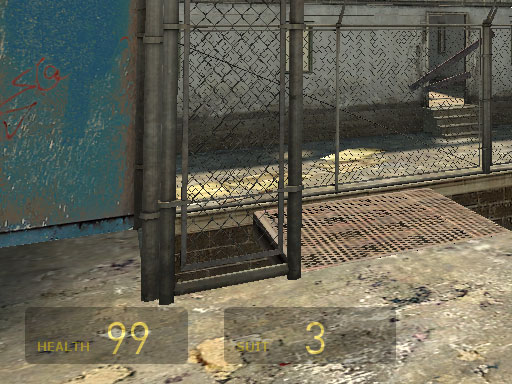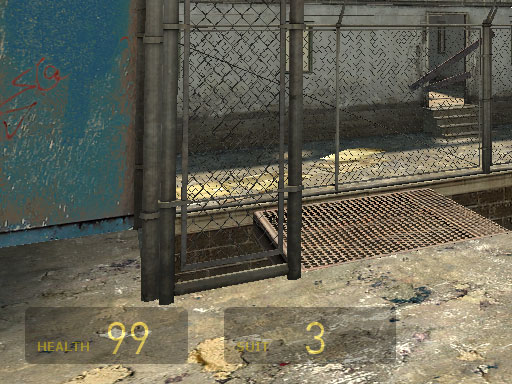Half Life 2 GPU Roundup Part 1 - DirectX 9 Shootout
by Anand Lal Shimpi on November 17, 2004 11:22 AM EST- Posted in
- GPUs
Turning on Anisotropic Filtering
For the most part Half Life 2 doesn’t absolutely beg for anisotropic filtering to be enabled, but there are definitely a few situations where image quality could be improved by turning it on.
Looking at the peach colored metal platform towards the right of the images before you can see some of the benefits of anisotropic filtering in Half Life 2:

Aniso Disabled

8X Aniso Enabled - ATI

8X Aniso Enabled - NVIDIA
So there's definitely an improvement with 8X anisotropic filtering enabled but the difference in image quality between ATI and NVIDIA is tough to quantify. The two look quite similar in our opinion, with ATI getting the nod for slightly better image quality (the difference is quite subtle).
One issue we found in Half Life 2 with anisotropic filtering enabled is that the amount of resulting texture shimmering was borderline unbearable. The shimmering was worse on NVIDIA cards than on ATI cards, but it was definitely present on both. Part of the cause of the shimmering was the fact that all modern ATI and NVIDIA cards have resorted to a less ideal method of distance calculation for anisotropic filtering, which contributes to the shimmering issues we noticed under Half Life 2. With the release of the GeForce 6 series, NVIDIA moved to a method of anisotropic filtering using a weighted manhattan distance calculation, similar to what ATI had been doing for quite a while. The problem with the weighted manhattan distance calculation is that it is much more sensitive to the orientation of a surface in respect to the viewer, which can cause more of these shimmering issues.
NVIDIA’s NV3x line used a Euclidean distance calculation that was less sensitive to surface orientation and thus reduced some of the shimmering issues we encountered under Half Life 2.
There are some levels in Half Life 2 where enabling anisotropic filtering improves image quality, but then there are others where image quality is improved at the expense of increased texture shimmering. Rest assured that the shimmer occurs on both ATI and NVIDIA cards and it seems that the only way to get around it (unless both ATI and NVIDIA choose to employ different methods of anisotropic filtering) is to leave it disabled if it bothers you enough.
In terms of anisotropic filtering image quality, we just showed that we were hard pressed to find any image quality differences between ATI and NVIDIA’s solutions under Half Life 2. In motion however, NVIDIA’s drivers did seem to cause more texture shimmering than ATI’s with anisotropic filtering enabled.










79 Comments
View All Comments
araczynski - Thursday, November 18, 2004 - link
yawn, i'm too busy enjoy the game (6800gt) to read the article and/or care which card is better :) i'm playing at 1600x1200 0AA/4AF (2.4@3.3/1GB) and have absolutely no complaints, other then knowing that the game will eventually end :(Jeff7181 - Thursday, November 18, 2004 - link
#57... poorly :)blckgrffn - Thursday, November 18, 2004 - link
I would also like to to see how the 9200/9000 series Radeons perform too, and if you have extra time, the 8500/9100.Again, Thanks!
Jeff7181 - Thursday, November 18, 2004 - link
#16... that's correct, although the only REAL observation that needs to be made is that Half Life 2 makes heavy use of pixel shaders which is very GPU dependant, and GPU's are just now growing the required testicles to process those shaders :)blckgrffn - Thursday, November 18, 2004 - link
Anand -I would like to see how the 6600 performs. As an 8 pipe card, it should perform better than the 9600xt and a little under a 9700 Pro, but it would be interesting to see if that is true. It is a great budget PCIe card along with the x700.
Thanks!
Nat
eva2000 - Thursday, November 18, 2004 - link
nice review downloaded your demos to run on AMD64 3700+ @ 12x 222 = 2664mhz with 1GB BH-5 @ 222mhz 2-2-2-6 1T and Powercolor X800XT PE @ 520/560 and all demo results were within 3-4fps of the reviews :)Live - Thursday, November 18, 2004 - link
Good reading as always. Would like to see minimum FPS tough. I find it very important to see how low the cards drop when stressed. You can't see that with only average FPS.housecat - Wednesday, November 17, 2004 - link
So... wheres the Nvidia SLI versus ATI results??Muwahahaha.
Avalon - Wednesday, November 17, 2004 - link
Hey Anand, I have an interesting request. Could you try Rivatuner on your 6800, unlock its pipes, and then bench it again? :PJust kidding. Actually, I'm glad you've confirmed what I've been thinking...that AF hasn't been doing much for me. Since I'm running on a lowly 9700, I think I'll just turn it off now, and enjoy a nice speed boost.
PrinceGaz - Wednesday, November 17, 2004 - link
How about throwing a GF 5600 and maybe even a GF 5200 in as well for part 2, as an awful lot of people have them. Ultra versions of either if you prefer.I don't have one of them myself as I'm still using a Ti4200, but it would be interesting to see how they stacked up in the DX8 codepath against the Ti4600 you are planning to test. And it should be worth a giggle to see just how "fast" the 5600 or 5200 can manage the DX9 codepath :)
Thanks to the resolution scaling-graphs this review included and how the fastest cards were generally CPU limited with that A64 4000+ when the resolution was dropped to 1024x768, I'm not sure how much a CPU scaling article for part 3 will show that can't already be quite accurately guesstimated from how different CPUs generally tend to perform in games. But a comparison of the Athlon 64 4000+, against an Athlon XP, a Prescott, a Northwood, and if time permits a fast P3, Duron and Celeron also, would be great.